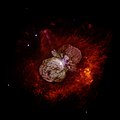檔案:Eta Carinae.jpg

Yi-lám thai séu: 600 × 599 chhiong-su. Khì-thâ kié-sak-thu: 240 × 240 chhiong-su | 480 × 480 chhiong-su | 769 × 768 chhiong-su | 1,025 × 1,024 chhiong-su | 2,015 × 2,013 chhiong-su.
Ngièn-pún tóng-on (2,015 × 2,013 chhiong-su, vùn-khien thai-séu: 163 KB, MIME lui-hîn: image/jpeg)
Vùn-khien li̍t-sṳ́
Tiám-khim ngit-khì / sṳ̀-kiên lòi chhà-khon tông-sṳ̀ chhut-hien-ko ke vùn-khien.
| Ngit khì / Sṳ̀-kiên | Suk-lio̍k-thù | Vì-thu | Yung-fu | Yi-kien | |
|---|---|---|---|---|---|
| tông-chhièn | 2017年12月18日 (Yit) 09:41 |  | 2,015 × 2,013(163 KB) | The NMI User | Reverted to version as of 14:14, 1 May 2008 (UTC) |
| 2017年3月13日 (Yit) 14:45 |  | 3,000 × 2,998(1.18 MB) | Leogorgon | larger file size | |
| 2008年5月1日 (Si) 14:14 |  | 2,015 × 2,013(163 KB) | Vol de nuit | {{Information |Description=(NASA News Release) A huge, billowing pair of gas and dust clouds are captured in this stunning NASA Hubble Space Telescope image of the supermassive star Eta Carinae. Using a combination of image processing techniques (ditheri |
Vùn-khien yung-chhú
Mò ya̍p-mien lièn-chiap to pún vùn-khien.
Chhiòn-vet tóng-on sṳ́-yung chhong-khóng
Hâ-lie̍t khì-thâ Wiki chûng sṳ́-yung liá-chak tóng on:
- da.wikipedia.org ke sṳ́-yung chhong-khóng
- en.wikipedia.org ke sṳ́-yung chhong-khóng
- Star
- Eta Carinae
- Wikipedia:Selected anniversaries/March 11
- Wikipedia:Today's featured article/March 2017
- Wikipedia:WikiProject Wikipack Africa Content/Wikipedia:Showcase
- Wikipedia:WikiProject WikiFundi Content/Eta Carinae
- Wikipedia:Today's featured article/requests/Eta Carinae
- Wikipedia:Today's featured article/March 12, 2017
- Wikipedia:Main Page history/2017 March 12
- Wikipedia:WikiProject WikiFundi Content/Wikipedia:Showcase
- Wikipedia:Main Page history/2022 March 11
- Wikipedia:Main Page history/2022 March 11b
- Wikipedia:Main Page history/2023 March 11
- Wikipedia:Main Page history/2023 March 11b
- User:2003 LN6/sandbox/Eta Carinae variable
- List of luminous blue variable stars
- en.wikiversity.org ke sṳ́-yung chhong-khóng
- User:Marshallsumter/Radiation astronomy2/Visuals
- User:Marshallsumter/Radiation astronomy2/Violets
- Stars/Astronomy
- User:Marshallsumter/Radiation astronomy2/Violets/Quiz
- Stars/Sun/Astronomy/Quiz
- User:Marshallsumter/Radiation astronomy/Courses/Principles/Hourly 2
- User:Marshallsumter/Radiation astronomy/Courses/Principles/Final quiz
- Draft:Original research/Io/Quiz
- Titan/Quiz
- Stars/Solar systems/Quiz
- Moon/Quiz
- Earth/Quiz
- User:Marshallsumter/Radiation astronomy/Colors/Quiz
- Volcanoes/Io/Quiz
- Stars/Violets
- User:Marshallsumter/Radiation astronomy2/Stars
- Stars/Violets/Quiz
- es.wikipedia.org ke sṳ́-yung chhong-khóng
- fr.wikipedia.org ke sṳ́-yung chhong-khóng
- hi.wikipedia.org ke sṳ́-yung chhong-khóng
- it.wikibooks.org ke sṳ́-yung chhong-khóng
- la.wikipedia.org ke sṳ́-yung chhong-khóng
- mk.wikipedia.org ke sṳ́-yung chhong-khóng
- ms.wikipedia.org ke sṳ́-yung chhong-khóng
- my.wikipedia.org ke sṳ́-yung chhong-khóng
- oc.wikipedia.org ke sṳ́-yung chhong-khóng
- ru.wikipedia.org ke sṳ́-yung chhong-khóng
- sk.wikipedia.org ke sṳ́-yung chhong-khóng
- sr.wikipedia.org ke sṳ́-yung chhong-khóng
- th.wikipedia.org ke sṳ́-yung chhong-khóng
Kiám-sṳ liá vùn-khien ke kiên-tô chhiòn-vet sṳ́-yung chhong-khóng.
